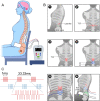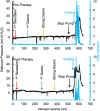Noninvasive spinal neuromodulation mitigates symptoms of idiopathic overactive bladder
- PMID: 35317851
- PMCID: PMC8941742
- DOI: 10.1186/s42234-022-00087-x
Noninvasive spinal neuromodulation mitigates symptoms of idiopathic overactive bladder
Abstract
Background: Overactive bladder (OAB) affects 12 to 30% of the world's population. The accompanying urinary urgency, frequency and incontinence can have a profound effect on quality of life, leading to depression, social isolation, avoidance of sexual activity and loss of productivity. Conservative measures such as lifestyle modification and pelvic floor physical therapy are the first line of treatment for overactive bladder. Patients who fail these may go on to take medications, undergo neuromodulation or receive injection of botulinum toxin into the bladder wall. While effective, medications have side effects and suffer from poor adherence. Neuromodulation and botulinum toxin injection are also effective but are invasive and not acceptable to some patients.
Methods: We have developed a novel transcutaneous spinal cord neuromodulator (SCONE™,) that delivers multifrequency electrical stimulation to the spinal cord without the need for insertion or implantation of stimulating electrodes. Previously, multifrequency transcutaneous stimulation has been demonstrated to penetrate to the spinal cord and lead to motor activation of detrusor and external urethral sphincter muscles. Here, we report on eight patients with idiopathic overactive bladder, who underwent 12 weeks of SCONE™ therapy.
Results: All patients reported statistically significant clinical improvement in multiple symptoms of overactive bladder, such as urinary urgency, frequency and urge incontinence. In addition, patients reported significant symptomatic improvements as captured by validated clinical surveys.
Conclusion: SCONE™ therapy represents the first of its kind therapy to treat symptoms of urgency, frequency and urge urinary incontinence in patients with OAB.
Trial registration: The study was listed on clinicaltrials.gov ( NCT03753750 ).
Keywords: Lower urinary tract; Non-invasive spinal cord stimulation; Overactive bladder; Urge urinary incontinence; Urodynamics.
© 2022. The Author(s).
Conflict of interest statement
V.R.E, holds shareholder interest in Onward and hold certain inventorship rights on intellectual property licensed by The Regents of the University of California to Onward.
V.R.E, E.K, and PG hold shareholder interest in SpineX Inc. and hold certain inventorship rights on intellectual property licensed by The Regents of the University of California to SpineX Inc.
Figures





Similar articles
-
OnabotulinumtoxinA 100 U significantly improves all idiopathic overactive bladder symptoms and quality of life in patients with overactive bladder and urinary incontinence: a randomised, double-blind, placebo-controlled trial.Eur Urol. 2013 Aug;64(2):249-56. doi: 10.1016/j.eururo.2013.04.001. Epub 2013 Apr 10. Eur Urol. 2013. PMID: 23608668 Clinical Trial.
-
A single-blind, randomized controlled trial to evaluate the effectiveness of transcutaneous tibial nerve stimulation (TTNS) in Overactive Bladder symptoms in women responders to percutaneous tibial nerve stimulation (PTNS).Physiotherapy. 2019 Dec;105(4):469-475. doi: 10.1016/j.physio.2018.12.002. Epub 2018 Dec 18. Physiotherapy. 2019. PMID: 30862384 Clinical Trial.
-
Neuromodulation for the Treatment of Lower Urinary Tract Symptoms.Low Urin Tract Symptoms. 2015 Sep;7(3):121-32. doi: 10.1111/luts.12087. Epub 2015 Feb 17. Low Urin Tract Symptoms. 2015. PMID: 26663726 Review.
-
Sacral neuromodulation in patients with idiopathic overactive bladder after initial botulinum toxin therapy.J Urol. 2013 Dec;190(6):2148-52. doi: 10.1016/j.juro.2013.07.017. Epub 2013 Jul 17. J Urol. 2013. PMID: 23872028
-
Management of OAB in those over age 65.Curr Urol Rep. 2013 Oct;14(5):379-85. doi: 10.1007/s11934-013-0338-5. Curr Urol Rep. 2013. PMID: 23922134 Review.
Cited by
-
Non-invasive central nervous system stimulation to improve bladder and pelvic floor function in the aging population.Curr Opin Urol. 2024 Nov 1;34(6):412-421. doi: 10.1097/MOU.0000000000001223. Epub 2024 Sep 4. Curr Opin Urol. 2024. PMID: 39233660 Free PMC article.
-
Beyond pediatrics: noninvasive spinal neuromodulation improves motor function in an adult with cerebral palsy.Bioelectron Med. 2024 Jan 3;10(1):1. doi: 10.1186/s42234-023-00133-2. Bioelectron Med. 2024. PMID: 38167312 Free PMC article.
References
-
- Amend B, Matzel KE, Abrams P, de Groat WC, Sievert KD. How does neuromodulation work. Neurourol Urodyn. 2011;30:762–765. - PubMed
-
- Cotterill N, Norton C, Avery KN, Abrams P, Donovan JL. Psychometric evaluation of a new patient-completed questionnaire for evaluating anal incontinence symptoms and impact on quality of life: the ICIQ-B. Dis Colon Rectum. 2011;54:1235–1250. - PubMed
Associated data
Grants and funding
LinkOut - more resources
Full Text Sources
Medical
